 Thank you for visiting HOJO website. If you have any enquiry, please feel free to get in touch with us at
Thank you for visiting HOJO website. If you have any enquiry, please feel free to get in touch with us at
▼ Akira Hojo
▼ Hojo Newsletter
▼ HOJO FACEBOOK





HOME > White Tea > Silver Needle
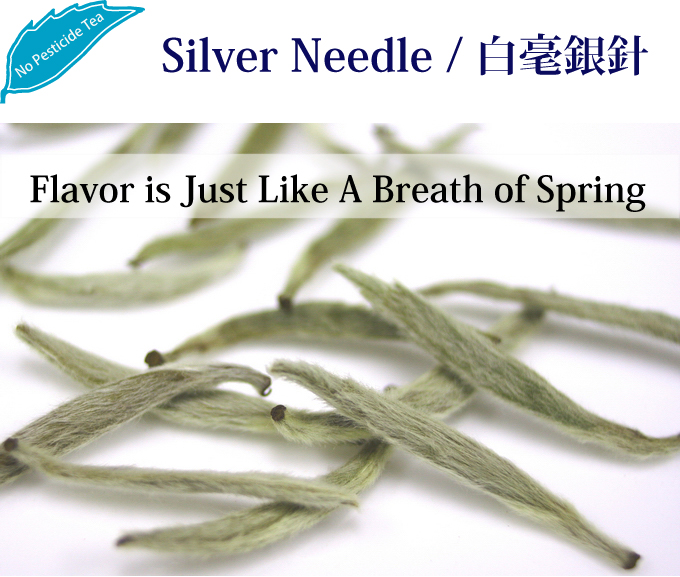

You can try brewing this tea in a long glass. Tea stands up along the surface of water once it absorbs the water. It looks just like a spear. On the next moment, each leaf starts moving up and down. It is so beautiful and reminds us of bamboo forest.
Silver Needle is packed inside a bag while the leaves are still hot. It is to avoid the leaves from cracking and also to allow the leaves to further mature. Due to this process, the tea leaves will absorb excessive moisture from air that is inside the bag. Many white teas available in the existing market give an unpleasant smell. Nevertheless we believe that the aroma of an authentic quality should be different and keep looking for the excellent quality. We have tasted more than 30 different samples and finally found the one that does not emit the usual unpleasant smell. We are very proud to introduce our white tea as its aroma is totally different from that of ordinary white tea. It gives a sweet flowery aroma which is just like the spring flower.
You can brew Silver Needle with cold water as well. For the cold water brewing, brewing time is more than 1 hour. Due to the low temperature, the flavor remains very fresh and the taste becomes thicker. Certainly, the tea can be brewed for a few times. For the second brewing onwards, you can pour either hot or cold water.
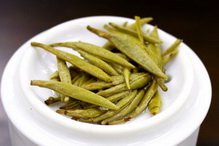
Look at the brewed leaves. It is very thick which indicates that the raw material used is of high grade and quality.
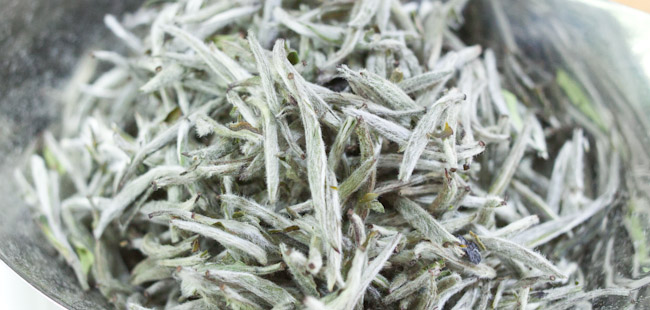
Good white tea is not white in color. Premium white tea is in jade color i.e., pale green in color. If the withering process is not properly conducted because of the tea is over dried or material is not gently handled, the color of leaf will change into a grayish, yellowish or sometimes brown color and its flavor is obviously affected.
It is not only a single bud that is plucked, but also its stem is plucked as well together with bud. The stem is then removed at the factory as to avoid the bud from being damage. Due to this intensive cautious handling, even an expert can pluck only 500g a day. After it is processed into white tea, it will be only 100g.
From 3g of tea leaves that is equivalent to one table spoon, you can brew almost 1 liter of tea.

Silver Needle is one of the rarest and most spectacular teas. The production of this tea merely makes up not even 0.1% of the tea produced in China. This needle shaped white tea is mainly produced in Fujian, China, which is famous for the outstanding quality of their white tea. Sri Lanka makes a small amount of silver tips white tea from a different varietals and they are making other styles of white tea in Darjeeling. The reason for the name, "Silver Needles", is quite apparent as with one glance at the buds; the prominence of the delicate white hairs on the buds is quite striking.
During early Spring, each bud is carefully plucked from the Da-bai cultivar (大白茶树 Da-bai cha-shu). White teas differed from green teas in that their processing does not incorporate any steaming or pan-firing. To produce Silver Needle, the tea has to undergo the long-hour withering which causes the non-enzymatic oxidation that gives the unique characteristics of white tea. The withered buds are then dried on smoldering fire (文火 Wen-huo). One of the unique processing steps is this tea is packed right after drying while the tea is still warm. This is vital to preserve its needle shape; if it is cooled down, the tea is susceptible to breakage while packing.
When brewed in hot water, the buds point upwards, and while remaining in the upright position, the water-absorbed buds gradually sink downward to the bottom of glass, which looks like stalactite.
HOJO particularly focuses on Silver Needle produced from Fu-Ding areas. In addition, we choose no-pesticide tea as our own particular standard.

A long time ago, legend has it that the people who lived at the Fujian area were experiencing a dry spell which was threatening the lives of the villagers. It was believed that a celestial plant was growing at a mountain in the Fujian region which was guarded by a black dragon. This plant is believed to cure many kinds of illnesses and it will bring up the water when the juice of this plant is dropped into the river which had run dry. Many villages went looking for this special plant but failed and subsequently were turned into rocks at the mountain. A young lady, whose two brothers also went there but were sacrificed, decided to try her luck too. When she reached the mountain, the black dragon attacked her viciously but she cunningly managed to kill the dragon. The young lady then was able to pluck the celestial plant and dropped its juice onto the people who has turned into rocks, and all the villagers were transformed back into human beings. Thanks to her courage and good effort, the villagers were very grateful to be alive. They transferred the plant from the mountain and planted it widely in their villages. Due to its silvery white color and needle shape, it was named "Silver Needle".
During the Song Dynasty (year 1107), white tea was developed using the tea leaves plucked from the specific tea cultivars, and processed according to the way of making green tea. Its unique process is also documented in the Ming Dynasty tea books. During the Qing Dynasty (1772-1782), the commercial production of white tea emerged. During early 19th century, Zheng-He district (政和) started its mass production of Silver Needles and mostly sold it to European countries; the production was interrupted during World War I (1918), and resumed after 1926. In year 1855, Fu-Ding district (福鼎) started the cultivation of Fuding Da-bai cultivar (大白茶树 Da-bai cha-shu). It then gave rise to the massive production of Silver Needle at Fuding district thanks to its fleshy bud which was highly appreciated.
White teas are mostly grown and produced in Fujian province. The original growing place is the mountainous area at 245m a.s.l. The average atmospheric temperature is 18.2?C, rainfall is at 2837.5 mm per year. At this area, there is a huge temperature difference between the day and night. During the day, there is sufficient sun light and tea leaves vigorously produce plentiful of substances such as amino acid and carbohydrate, which are essential for the production of exclusive quality tea which will well influence its growth. At night, if the temperature is high, the metabolism is continually taking place, and the tea leaves will consume the substances that were produced during the day time. However, at the mountain area, the lower atmospheric temperature at night caused tea leaves to become less active and therefore those substances remain in the leaves. It contributes to the mellow taste of tea.
The main cultivars are the Fu-Ding Da-bai-cha (福鼎大白茶) and Zheng-He Da-bai-cha (政和大白茶). These cultivars are suitable for making Silver Needle because of its fleshy bud.
After pruning by machine, the first batch of Spring tea leaves is the fleshiest leaves for the white tea. White teas are often picked when the buds are tightly enclosed in new leaves. Only one fleshy bud or one bud and one leaf are picked. These leaves maintain the silky white hairs that denote new growth.
White teas are the least processed of all teas and are not rolled prior to drying. Since they have such little processing these hairs are often intact in the final product.
When all the tea leaves plucked they are sent to the production area, and the peeling process is carried out to remove excessive leaf from the bud. Hold the body of twig with the thumb and forefinger, and then remove the leaf in a backward motion; the single bud with stem is remained. The movement must be light and fast so as not to cause damage to bud.
This is one of the key processes which contribute to the quality of the finished product. The buds are spread on the perforated bamboo plate, and placed under the weak sunshine or in a room with good aeration. In order to preserve its good quality, much care must be taken:
During windy days with sufficient sunshine, the drying is carried out under the sun. In this case, the withered bud is dried for a day, and the moisture is reduced to 10-30%. Further drying is carried out using smoldering fire (文火Wen-huo). It is carried out using the bamboo basket (焙笼 Bei-long). The temperature is at 30-40?C for about 30 minutes. A white paper sheet is placed at the bottom of the bamboo basket in order to prevent the high fire or flame from burning the tea which causes the color of the bud to turn yellow.
After drying, the tea is sifted, and picked to remove the long stem and flakes. It is then re-fired until the moisture drops to 4-5% and then immediately packed while the tea is still warm. This is important to prevent the bud from breakage. This is different from other tea, where it is dried to about 8% of moisture, cooled down and packed. In the package, the tea will continue to evaporate moisture and then re-absorb the moisture when it is cooled down. Usually, the moisture of the finished tea is about 8-10%.
Contains fleshy buds in straight needle-shapes, covered with a silvery white down that is indicative of reserved quality white tea. Poor quality tea is mixed with broad strips of leaves and/or skinny bud. Some are 'chopped' and without tips. It also contains a lot of leaves which are blackish in color.
Good quality Silver Needle shows silvery grayish green color and the white down is evenly covers the bud. It looks lustrous and bright. Poor quality tea is in either reddish color caused by drying at high temperature or damaged during withering. If the tea is over-fired during drying, the bud shows a dull appearance with yellowish color. The bud is in dark moldy color if it is not well-dried or the drying temperature is too low.
When brewed, the liquor gives a scent of a fresh green note.
Bright, clear, with very light almond-like yellowish color.
Mellow, smooth and without astringency. It gives a fresh green note with a mild sweet after taste lingering on the tongue.
The brewed buds show delicate, bright and even yellowish green color. When touched with the finger, the buds are thick but soft and elastic. If its of poor quality, the bud is either yellowish green or dark green color, with a dull appearance. When touched, the bud is thin.
To enjoy Silver Needle with a well balanced aroma and flavor, the suitable teapot for Silver Needle is red clay teapot. Make sure to rinse the tea pot with boiling water for about 10-20 seconds in order to warm it up. Use 3g of tea leaves for 150ml of water. Quickly rinse the tea leaves with 80 degree Celsius of hot water. Gently pour hot water 80-85 degree Celsius into the teapot, let it brew for 30 seconds. For 2nd brewing, please keep the brewing time exactly the half the time of the 1st brewing.
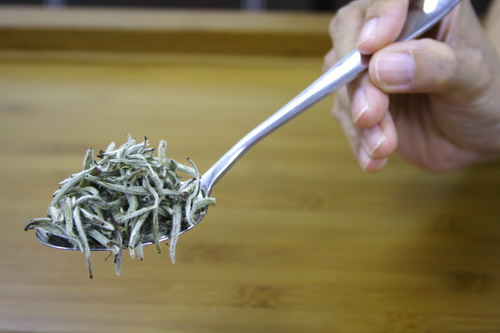
Take 3g of tea leaves for 150〜200ml of water. This photo shows 3g of tea leaves that is equivalent to one table spoon.
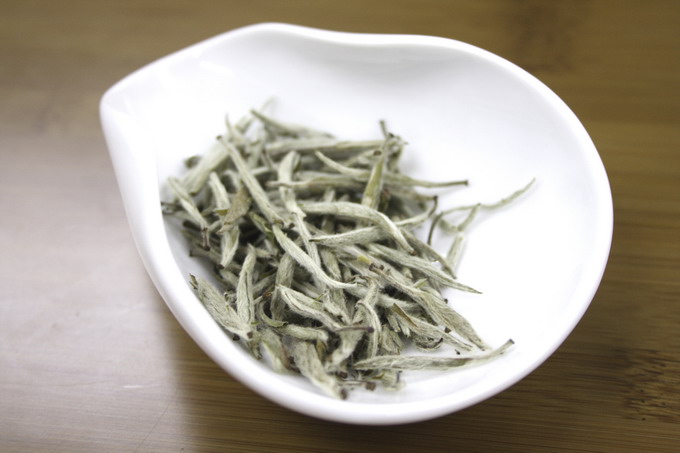
This is HOJO's Silver Needle. The color of leaf is very consistent.
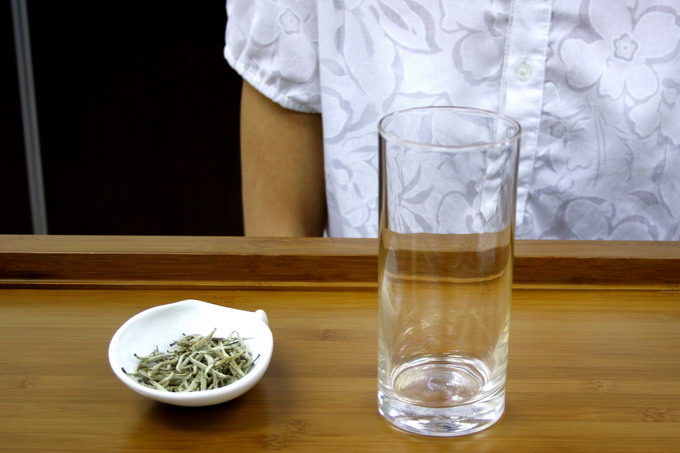
Use a simple and plain long glass.
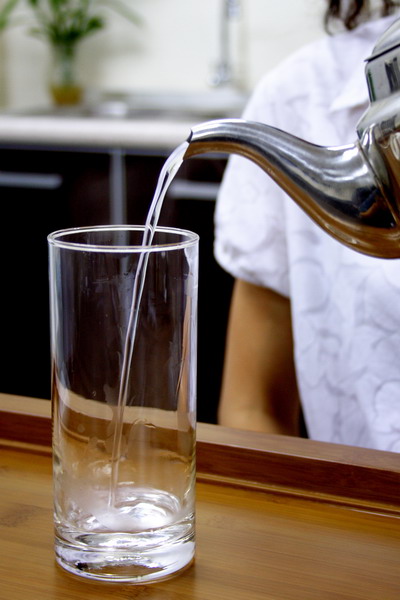
Pour the hot water into a long glass to warm it up.

After 10-30 seconds, pour off hot water when the glass is warmed up.
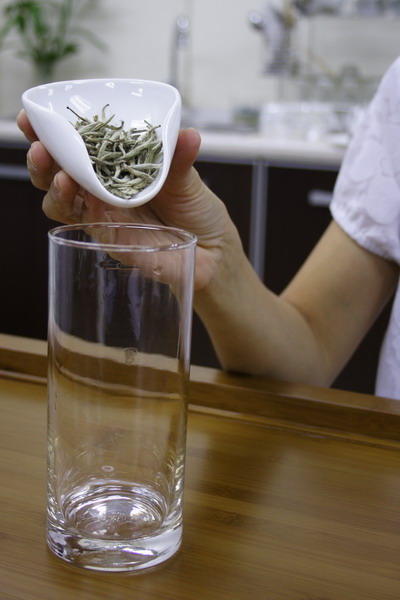
Place tea leaves into the long glass.

Tea leaves covers the bottom of glass.
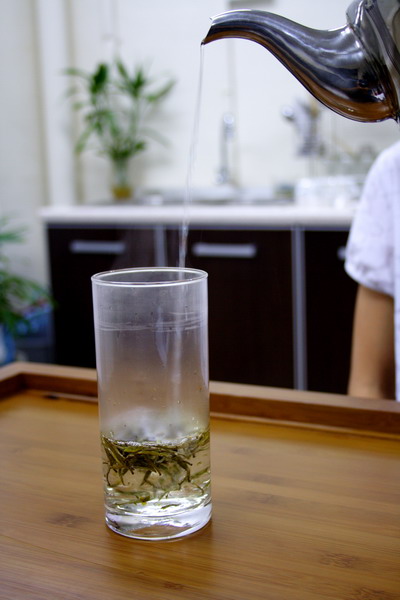
Pour in water at 90 degree Celsius until it covers about 1/3 of glass.
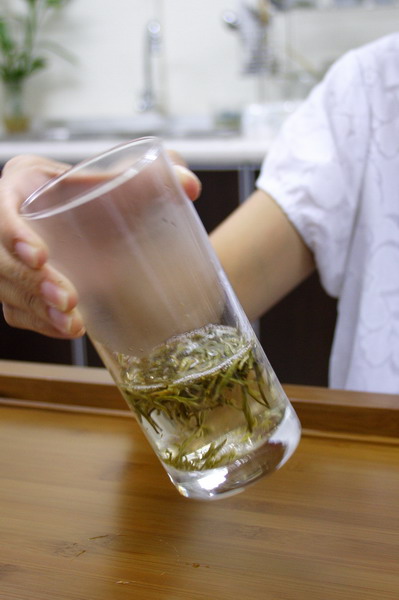
Gently sway the glass to let tea leaves absorb the water. If we skip this process, most of tea leaves will float on the surface.
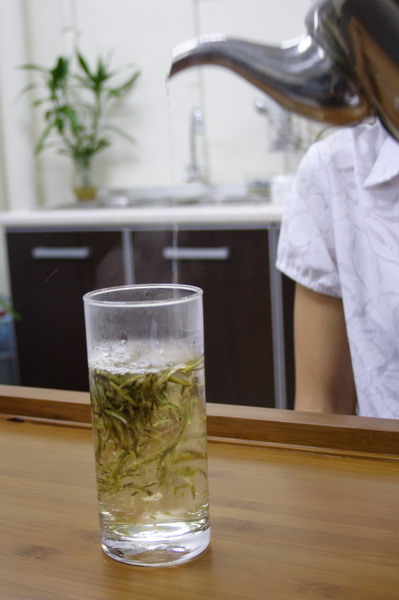
After 2 minutes, pour in the rest of the water.

Brew for 2-3 minutes.
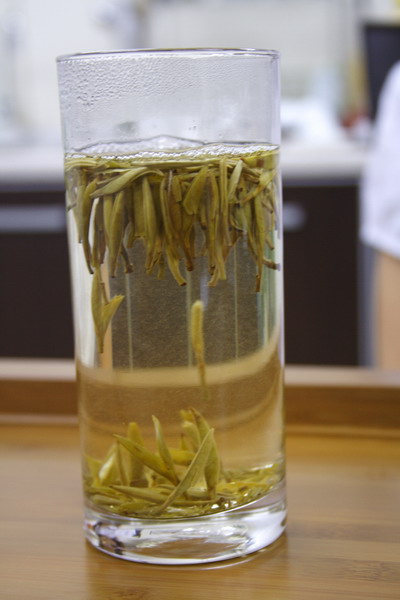
When Silver Needle starts absorbing water, it will stands up and move upward and downward in water.
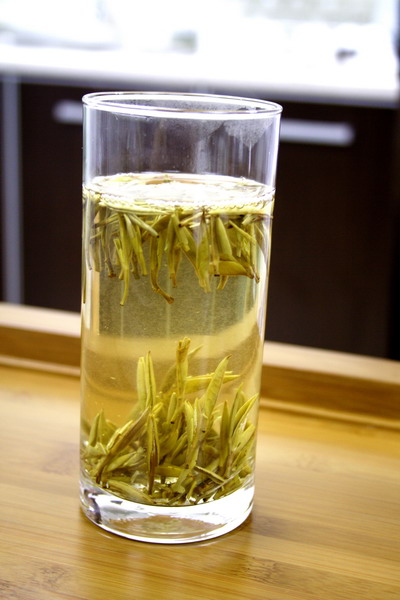
Silver Needle is processed without rolling process unlike to other types of tea. Therefore we need to brew it much longer time. In addition, you can brew for many times and you can enjoy the similar taste consistently.
Gai-wan is also a good way to brew white tea. Take 3g of tea leaves for 150〜200ml of water.
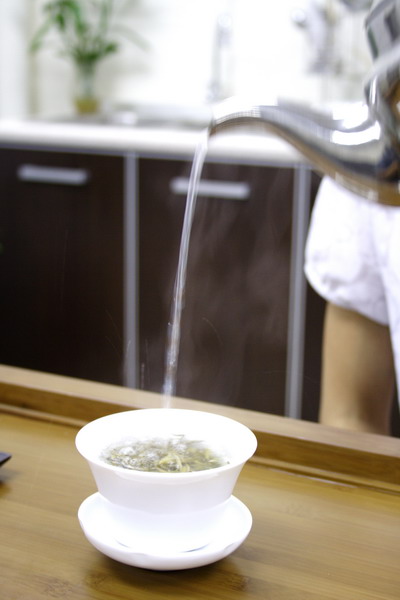
Pour in hot water from a high position so as to agitate the tea leaves.
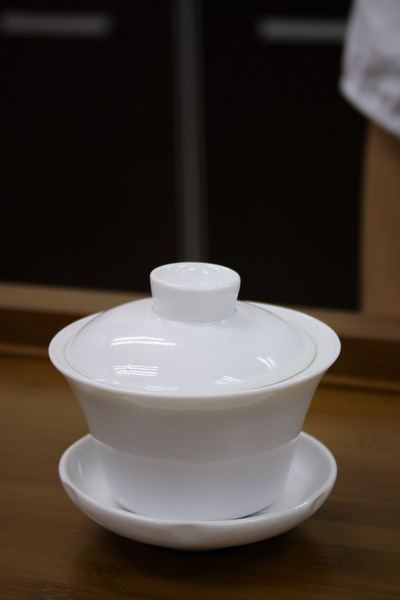
Brew for more than 5 minutes
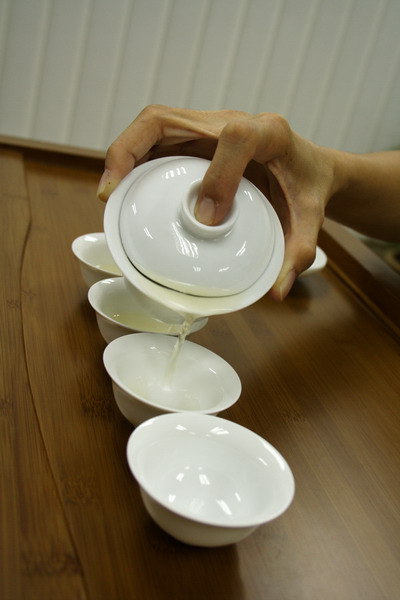
Pour straight into all the cups and move back and forth to equalize the concentration of tea for each cup.
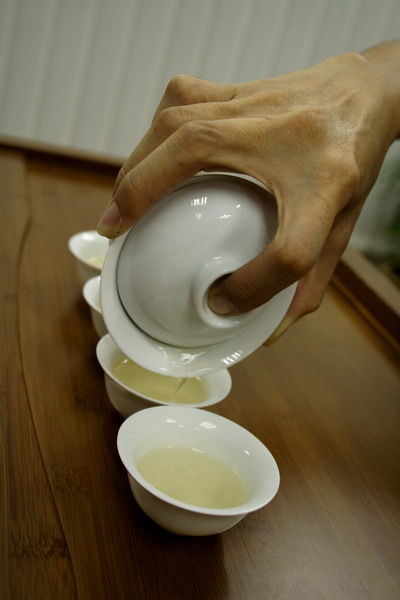
Hold the cap when pouring out the tea.
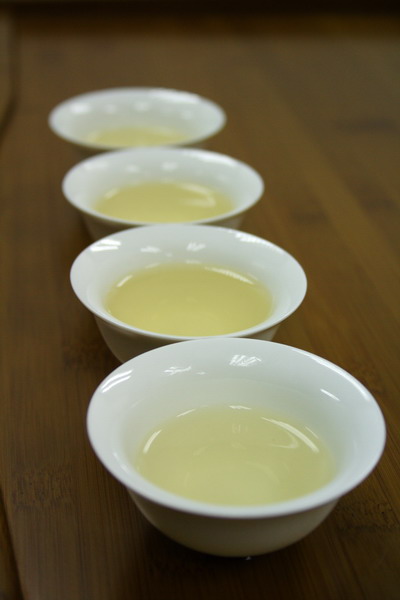
You can now enjoy the mild, thick and sweet taste of white tea.
White tea can be brewed with cold water as well. It is necessary to use either mineral water or filtrated water in order to avoid the chlorine smell. Use 3g of tea leaves for 200ml of water and leave it for more than 30 minutes. The taste of tea brewed using cold water is more natural and you might enjoy the greenish flavor. The color of tea tends to be rather colorless, yet it gives a rich taste.
Once a bag of tea is opened, please finish it within 3 months if you wish to enjoy its freshness. From the medical point of view, it is safe to consume the tea even if it is kept for a few years. However the freshness disappears if it is kept for too long. Tea must be tightly sealed before it is kept. Tea should be kept in ambient and dry conditions such as in the living room, but it must be completely away from humidity. Tea should not be kept in the kitchen as the environment is very humid. Avoid enclosed area such as inside the cupboard or drawer as these places are damp. Also avoid opening the bag of tea in humid atmosphere. It is recommended to open the bag during a sunny day or under air-conditioned atmosphere. Once tea leaves absorb moisture, deterioration of tea will be triggered within a few days. Tea will then give an astringent taste, sometime it tastes sour. The fresh aroma also becomes weaker.
The quality of tea lasts longer if it is kept in the fridge. However we strongly recommend you not to keep tea in the fridge. When tea is withdrawn from the fridge, there is usually condensation. Once tea is exposed to moisture during condensation, the quality will deteriorate within a few days. The higher moisture content in the tea leaves will trigger oxidation and it will completely destroy the quality of tea.
Here’s one frequently asked question: what happens if bag is sealed using tape or tea is packed in zipper bag and kept inside the fridge?
For your information, these simple sealing methods are not sufficient. When the bag is withdrawn from the fridge, it is cold inside the bag and therefore causes negative pressure. Air will be drawn from outside and condensation will occur. In addition, if the bag is taken in and out from the fridge very often, this will cause heat stress to the tea leaves as temperature is increased and decreased very frequently. If tea is kept in the fridge, when it is withdrawn from the fridge, it is necessary to leave it in ambient atmosphere for more than 24 hours in order to warm up the tea leaves. Based on our experience, 12 hours is not long enough. We may think tea is warmed up, but inside the bag, the tea leaves are still cold due to insulation effect.

Please feel free to send us e-mail for enquiry at:

 |
We accept various kinds of credit card through Paypal.
Only if customer prefer other option of payment, we suggest "Bank Transfer".
Various choice of shipping method
EMS, SAL, Small Packet, Small Packet (SAL) Yamato Express and Surface
For shipping tea, we usually suggest small air parcel, the estimated shipping cost of tea in 100g (with wrapping material ) is
Small Parcel
USA JPY 600, EU JPY600 and Asia JPY470
Small Packet (SAL)
USA JPY380, EU JPY380 and Asia JPY320
The shipping fee to oversea by small air parcel happens to be even cheaper than domestic shipping fee in Japan.
For your information, some countries, EU in particular imposes custom duty. We need buyer to bare the duty. We are sorry, but we cannot change the amount on the invoice, and we do not mark any packages as gifts. We will strictly follow the custom regulation.